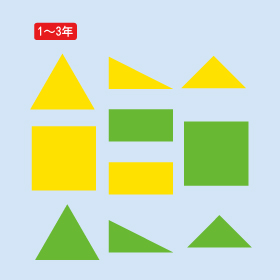After the Welcome Ceremony on the first day of school, the brand new first graders and their fully dressed up parents are lead by the teacher to their classroom where each desk is beautifully prepared with a yellow hat, new textbooks, 算数セット(Sun-soo-set; the set of basic math manipulatives) box, and perhaps more goodies.
Although there are some varieties in the math manipulative boxes depending on the company, the basic items are similar and support early mathematical experiences no matter which company's textbooks they use. The fundamental mathematics skills in the first grade and early second grade are very critical. These kids are lucky to have their individual math set of their own. It has been a trend that most young families want to purchase everything new for their own brand new first grader, however, there are more schools that reuse and recycle for the next first graders to decrease families expenses, according to the Asahi Shinbun Newspaper 2009.
Here are some items I would like to have for our American Kindergartners, First graders, and Second Graders.
Item 1: A Clock
The Common Core State Standards Math 1st Grade.Measurement and Data, a.k.a. MD.3, 2.MD.7 (second grade), and 3.MD.1 (third grade) indicate the telling time. Visual support and practice are very effective, especially in the relaxed learning environment. Teachers can be creative in order to reinforce telling time skills. Although Kindergarten CCSS doesn't require telling times, how fun to explore the clock in the math station activities?
Item 2: A personal magnetic board and multi colored magnets (preferably 20 pieces in each color)
These items works for any kind of number sense activities such as counting, matching, comparing, adding, subtracting, and representing the place values in the cart. Additionally, multiplication and division are simply explained by 3rd grade students. Thus, Counting Cardinality (K), Operations and Algebraic Thinking (K-3), Number and Operations in Base 10 (K-3) are all covered with this simple manipulative set including 4th and 5th grade intervention lessons. Because they are magnetic, kids don't lose small pieces as much as non magnetics.
Item 3: Magnetic Colored Shapes
A variety of two dimensional polygons can be introduced and explored with the Geometry Standards in CCSS K-5. I am more curious to have the magnetic Tangram Puzzle Shape. Individual and group activities including rich discussion will be guaranteed, perhaps, with some academic vocabulary. Like item 2, each shape hardly gets lost because of the magnetized materials.
The counting sticks support Counting and Cardinality (K) and Number and Operations in Base Ten (K-3). Multiple practices with these items strengthen students' familiarity in the foundational number sense. Cognitive understanding of number sense doesn't come in over night. While young students purposefully and accurately manipulating these items, it develops. You would be surprised at how many second grade students count items inaccurately. It is great though, because that is why they practice over and over. It is a great opportunity for them to make mistakes in the classroom. Any mistakes will become concrete understanding in the hands-on experiences.
Item 5: 10 Frame Cards
10 frame is another way to develop concrete understanding of number 10. These cards should be laminated and used frequently. The activities include compose numbers under 10 and decompose 10. Students visually respond to what number make 10 and identify how many more than 5 is 6, 7, 8, 9, and 10. Here is my favorite 10 Frame game in the illuminations.nctm.org.
If kids have these five items in daily basis, each upcoming grade year in math will be smoother. If the school supplies these math manipulatives for all classrooms of K, 1, and 2, teachers don't have to dig for certain items buried in the stuff room in addition to strengthen the standard based skills. Having common tools give students freedom to ask their own questions and find their own solutions and explanations among peers. It employs to the entering level of all 1-8 in Mathematics Standards for Mathematical Practice.






Do you know where I can purchase a set for my students?
ReplyDeleteI wish I could purchase for my students in the U.S. They are available in Japan. I wonder if the company send them for you.
ReplyDelete